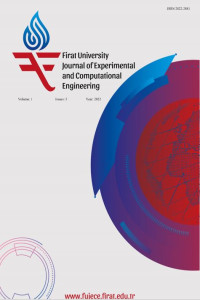Öz
Kaynakça
- 1] Hoornweg D, Bhada-Tata P. "What a waste: a global review of solid waste management". https://openknowledge.worldbank.org/handle/10986/17388 (12.09.2022).
- [2] Gundupalli S.P, Hait S, Thakur,A. "Multi-material classification of dry recyclables from municipal solid waste based on thermal imaging". Waste Management , 70, 13-21, 2017.
- [3] Zhang Q, Yang Q, Zhang X, Bao Q, Su J, Liu X. "Waste image classification based on transfer learning and convolutional neural network". Waste Management, 135, 150-157, 2021.
- [4] Mao WL, Chen LW, Wang CT, Lin YH. "Recycling waste classification using optimized convolutional neural network". Resources, Conservation and Recycling, 164, 105132, 2021.
- [5] Nowakowski P, Pamuła T."Application of deep learning object classifier to improve e-waste collection planning". Waste Management, 109, 1-9, 2020.
- [6] Altikat A, Gulbe A, Altikat S. " Intelligent solid waste classification using deep convolutional neural networks". International Journal of Environmental Science and Technology, 19(3), 1285-1292, 2022.
- [7] Zhang Q, Zhang X, Mu X, Wang Z, Tian R, Wang X, Liu X. "Recyclable waste image recognition based on deep learning". Resources, Conservation and Recycling, 171, 105636, 2021.
- [8] Wang C, Qin J, Qu C, Ran X, Liu C, Chen B. "A smart municipal waste management system based on deep-learning and Internet of Things". Waste Management, 135, 20-29, 2021.
- [9] Sekar S. "Waste Classification data". https://www.kaggle.com/datasets/techsash/waste-classification-data (08 09 2022).
- [10] He K, Zhang X, Ren S, Sun J. "Deep residual learning for image recognition". In Proceedings of the IEEE Conference On Computer Vision and Pattern Recognition, Las Vegas, NV, USA, 27-30 June 2016.
- [11] Sharma S, Sharma S, Athaiya A. "Activation functions in neural networks". Towards Data Science towards data science, 6(12), 310-31, 2017.
Öz
Managing waste in big cities is a big problem. Wastes are dangerous in terms of causing environmental pollution and affecting human
health. In particular, solid wastes such as glass and plastic do not dissolve in the soil for a long time and pollute the environment. By
recycling such solid wastes, the surrounding waste can be reduced. Therefore, it is important to classify waste and to recycle the
separated waste. In this study, a data set consisting of 22500 waste images was used. The data set contains color image data with a size
of 227 x 227 pixels. The data used in the study are divided into two as organic and recyclable waste. This study proposes a deep
learning-based system for classifying waste. With such a system, wastes can be classified and recycled. The data was trained with the
ResNet 50 architecture and the CNN architecture created to classify waste, and accuracy rates were compared. The CNN architecture
created to classify waste is more successful for this data set with an accuracy rate of 91.84%.
Anahtar Kelimeler
Waste classification Deep learning Convolutional neural network ResNet-50 architecture
Kaynakça
- 1] Hoornweg D, Bhada-Tata P. "What a waste: a global review of solid waste management". https://openknowledge.worldbank.org/handle/10986/17388 (12.09.2022).
- [2] Gundupalli S.P, Hait S, Thakur,A. "Multi-material classification of dry recyclables from municipal solid waste based on thermal imaging". Waste Management , 70, 13-21, 2017.
- [3] Zhang Q, Yang Q, Zhang X, Bao Q, Su J, Liu X. "Waste image classification based on transfer learning and convolutional neural network". Waste Management, 135, 150-157, 2021.
- [4] Mao WL, Chen LW, Wang CT, Lin YH. "Recycling waste classification using optimized convolutional neural network". Resources, Conservation and Recycling, 164, 105132, 2021.
- [5] Nowakowski P, Pamuła T."Application of deep learning object classifier to improve e-waste collection planning". Waste Management, 109, 1-9, 2020.
- [6] Altikat A, Gulbe A, Altikat S. " Intelligent solid waste classification using deep convolutional neural networks". International Journal of Environmental Science and Technology, 19(3), 1285-1292, 2022.
- [7] Zhang Q, Zhang X, Mu X, Wang Z, Tian R, Wang X, Liu X. "Recyclable waste image recognition based on deep learning". Resources, Conservation and Recycling, 171, 105636, 2021.
- [8] Wang C, Qin J, Qu C, Ran X, Liu C, Chen B. "A smart municipal waste management system based on deep-learning and Internet of Things". Waste Management, 135, 20-29, 2021.
- [9] Sekar S. "Waste Classification data". https://www.kaggle.com/datasets/techsash/waste-classification-data (08 09 2022).
- [10] He K, Zhang X, Ren S, Sun J. "Deep residual learning for image recognition". In Proceedings of the IEEE Conference On Computer Vision and Pattern Recognition, Las Vegas, NV, USA, 27-30 June 2016.
- [11] Sharma S, Sharma S, Athaiya A. "Activation functions in neural networks". Towards Data Science towards data science, 6(12), 310-31, 2017.
Ayrıntılar
| Birincil Dil | İngilizce |
|---|---|
| Konular | Yazılım Mühendisliği |
| Bölüm | Research Articles |
| Yazarlar | |
| Yayımlanma Tarihi | 28 Ekim 2022 |
| Yayımlandığı Sayı | Yıl 2022 Cilt: 1 Sayı: 3 |
Kaynak Göster
Cited By
Bu eser Creative Commons Atıf-GayriTicari 4.0 Uluslararası Lisansı (CC BY NC) ile lisanslanmıştır.


